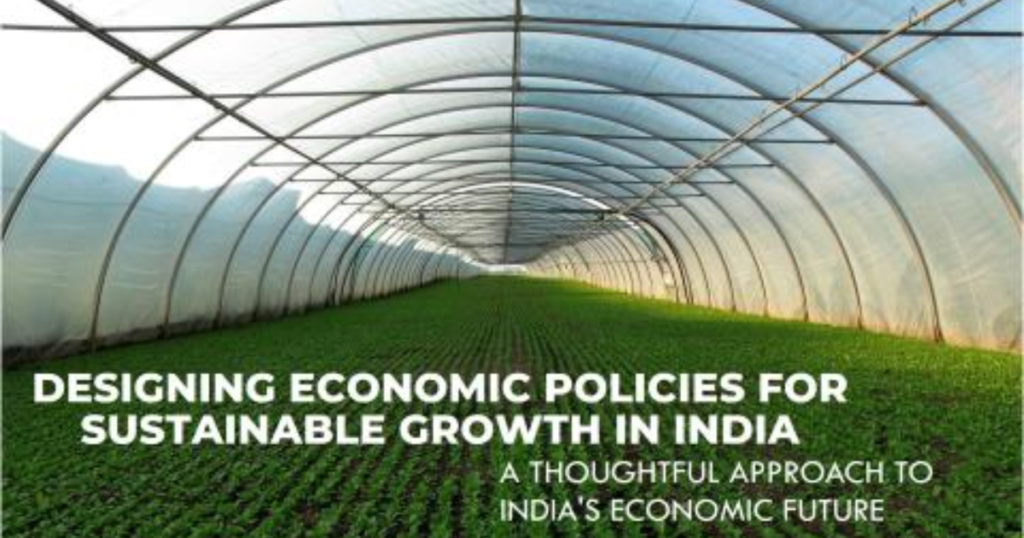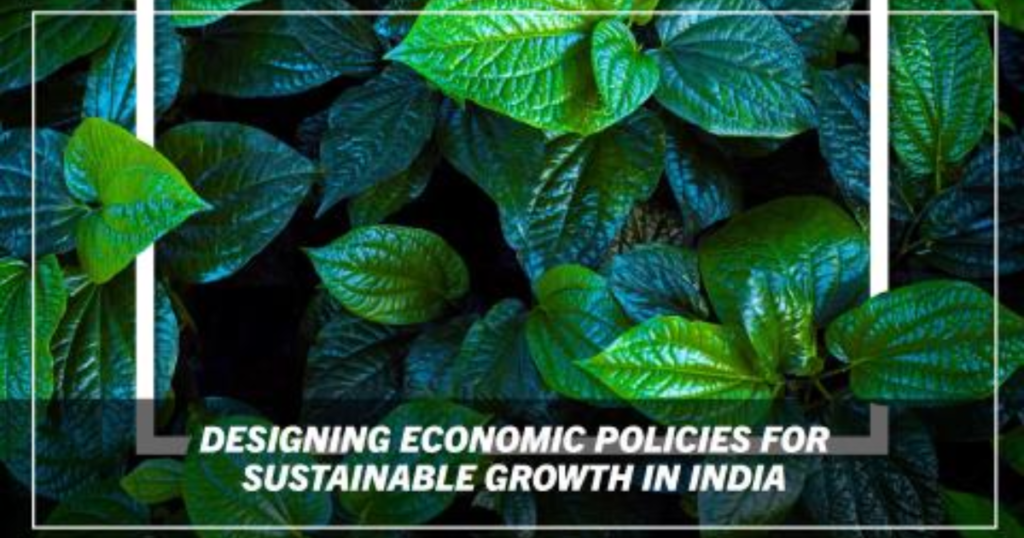Introduction:
Economic policies for sustainable growth in India must strike a delicate balance between present needs, future interests, and the imperative of environmental stewardship. As the world grapples with the challenges of climate change, social inequality, and economic uncertainties, India finds itself at a crucial juncture where visionary policies can shape a resilient and inclusive future. This article delves into India’s Economic Policies for Green Future that hold the key to achieving sustainable growth for India, considering the nation’s current status as the third-largest producer of renewables and its commitment to initiatives fostering innovation, financial inclusion, urban planning, and international cooperation.

- Renewable Energy and Green Infrastructure:
- Innovation and Digitalization: India’s Economic Policies
- Financial Inclusion and Access to Credit:
- Urban Planning and Governance: India’s Economic Policies
- Regional and International Cooperation:
- The challenges to sustainable growth in India-India’s Economic Policies
- Conclusion: India’s Economic Policies
- People Also Ask: India’s Economic Policies
- Disclaimer
Renewable Energy and Green Infrastructure:
India’s transition to a sustainable future begins with a robust commitment to renewable energy and green infrastructure. As the third-largest producer of renewables, with 42% of power sourced from clean options, India has a solid foundation. To further reduce dependence on fossil fuels and lower greenhouse gas emissions, continued investment in solar, wind, hydro, and biofuels is imperative. Policies must incentivize private sector participation. And research in these areas to harness the full potential of India’s renewable energy sector.
Innovation and Digitalization: India’s Economic Policies
Promoting innovation and digitalization is pivotal for enhancing productivity, efficiency, and global competitiveness. Initiatives like Make in India, Digital India, and Samagra Shiksha Abhiyan demonstrate a commitment to fostering innovation and skill development. To sustain this momentum, policies should encourage research and development, provide incentives for technology adoption. And bridge the digital divide, especially in agriculture, health, education, and manufacturing sectors.
Financial Inclusion and Access to Credit:
Ensuring financial inclusion is paramount for sustainable growth, particularly for small and medium enterprises, farmers, and informal workers. Policies such as Pradhan Mantri Jan Dhan Yojana, Pradhan Mantri Jan Arogya Yojana, and MGNREGA have already laid the groundwork for financial security and social protection. Ongoing efforts should focus on streamlining and expanding these schemes, creating a more inclusive financial ecosystem.
Urban Planning and Governance: India’s Economic Policies
Improving urban planning and governance is crucial for enhancing the quality of life and sustainability of urban areas. The National Smart Cities Mission and the Jal Jeevan Mission are commendable initiatives. Policies should prioritize the development of smart cities, efficient public transport, waste management, and water supply. Additionally, citizen participation and accountability mechanisms must strengthened to ensure the success of urban sustainability initiatives.

Regional and International Cooperation:
Strengthening regional and international cooperation is vital to address common challenges and leverage India’s strategic position. Commitment to multilateral forums, trade agreements, and climate action plans, including the Paris Agreement, Sustainable Development Goals. And the Regional Comprehensive Economic Partnership, demonstrates India’s global engagement. Policies should further encourage collaboration, opening avenues for shared growth and sustainable development.
The challenges to sustainable growth in India-India’s Economic Policies
As India endeavors to carve a path toward sustainable growth, it confronts a myriad of challenges that require thoughtful solutions. These obstacles, ranging from environmental concerns to social inequalities and infrastructural limitations, present complex hurdles on the journey to a resilient and inclusive future.
1. High Carbon Intensity: Tackling India’s Fossil Fuel Reliance
Challenge: India’s heavy reliance on coal and fossil fuels poses a significant challenge to sustainable growth. Approximately 70% of its primary energy consumption and 80% of electricity generation are derived from these non-renewable sources, making India one of the world’s largest greenhouse gas emitters.
Implications: The consequences of high carbon intensity include exposure to climate change risks, such as extreme weather events, water scarcity, and rising temperatures. Balancing economic growth with a transition to cleaner energy sources becomes imperative for long-term sustainability.
2. Low Human Capital: Bridging Gaps in Education and Health
Challenge: While India’s population is poised to reach 1.5 billion by 2030, the quality and quantity of human capital face a substantial gap. Factors such as inadequate education, healthcare, and skills development contribute to India ranking 116th out of 157 countries on the Human Capital Index.
Implications: Low human capital not only hinders the potential productivity of the workforce but also perpetuates poverty, inequality, and social exclusion. Addressing these challenges is vital for fostering a skilled and healthy populace, driving sustainable economic growth.
3. Inadequate Infrastructure: Bridging Gaps for Development
Challenge: India’s infrastructure, often insufficient, inefficient, and outdated, poses a hindrance to economic growth. The nation needs a substantial investment of about $1.5 trillion over the next decade to meet burgeoning demand and aspirations.
Implications: Regulatory hurdles, land acquisition issues, environmental concerns, and governance gaps contribute to the challenges in financing, building, and maintaining infrastructure. These issues impact the overall economic development and hinder India’s ability to compete on a global scale.
A Call to Action–India’s Economic Policies
Addressing these challenges requires a concerted effort from policymakers, businesses, and civil society. The imperative is not just to acknowledge these hurdles but to actively seek sustainable solutions. By transitioning to cleaner energy sources, investing in human capital, and overcoming infrastructural barriers, India can surmount these challenges and lay the foundation for a future characterized by sustainable growth, social equity, and environmental resilience. It is through collaborative and innovative efforts that India can navigate these hurdles and emerge stronger on the path to sustainable development.
Conclusion: India’s Economic Policies
While the potential for sustainable growth in India is evident, the realization of this vision hinges on the effective implementation of well-crafted economic policies. A collaborative effort involving the central government, states, and the business sector is essential. Strong political will, effective coordination, and adequate resources will be critical in creating an enabling environment for sustainable development. As India charts its course towards a resilient future, these policies serve as a blueprint for fostering inclusive growth, environmental stewardship, and global collaboration.
People Also Ask: India’s Economic Policies
- How can we ensure sustainability of development in India?
Ensuring sustainability of development in India requires a multi-faceted approach. Implementing policies that promote renewable energy adoption, investing in education and healthcare, fostering innovation, and prioritizing environmental conservation are crucial steps. Additionally, encouraging responsible business practices, promoting inclusive development, and fostering community engagement contribute to long-term sustainability.
- How do you ensure sustainable economic growth?
Sustainable economic growth hinges on balancing economic prosperity with environmental and social considerations. This involves promoting green technologies, investing in renewable energy, implementing responsible fiscal policies, and ensuring social inclusivity. Encouraging innovation, supporting small and medium enterprises, and maintaining a balance between resource consumption and conservation are key components of fostering sustainable economic growth.
- What are the recent policy initiatives taken by India to achieve the sustainable development goals?
India has undertaken several recent policy initiatives to align with sustainable development goals. Notable efforts include the Pradhan Mantri Jan Dhan Yojana, promoting financial inclusion; Swachh Bharat Abhiyan, focusing on sanitation and waste management; and the National Solar Mission, emphasizing renewable energy. Additionally, initiatives like Make in India and Digital India aim to boost economic growth while aligning with sustainable development principles. The adoption of the Sustainable Development Goals (SDGs) framework itself reflects India’s commitment to a holistic and sustainable development agenda.
Disclaimer
This article has been created on the basis of internal data, information available publicly, and other reliable sources to be believed. The article may also include information which are the personal views/opinions of the authors. The information includes in this article is for general, educational, and awareness purposes only and is not a full disclosure of every material fact.
All the information on this website i.e. World Virtual CFO – is published in good faith and for general information purposes only. World Virtual CFO does not make any warranties about the completeness, reliability, and accuracy of this information. These are my views for only information purposes. Any action you take upon the information you find on this website (World Virtual CFO), is strictly at your own risk. World Virtual CFO will not be liable for any losses and/or damages in connection with using our website. For details please refer to our disclaimer page.
Dr. Dinesh Sharma is an award-winning CFO and AI strategist with over two decades of experience in financial leadership, digital transformation, and business optimization. As the founder of multiple niche platforms—including WorldVirtualCFO.com—he empowers professionals and organizations with strategic insights, system structuring, and innovative tools for sustainable growth. His blogs and e-books blend precision with vision, making complex financial and technological concepts accessible and actionable.